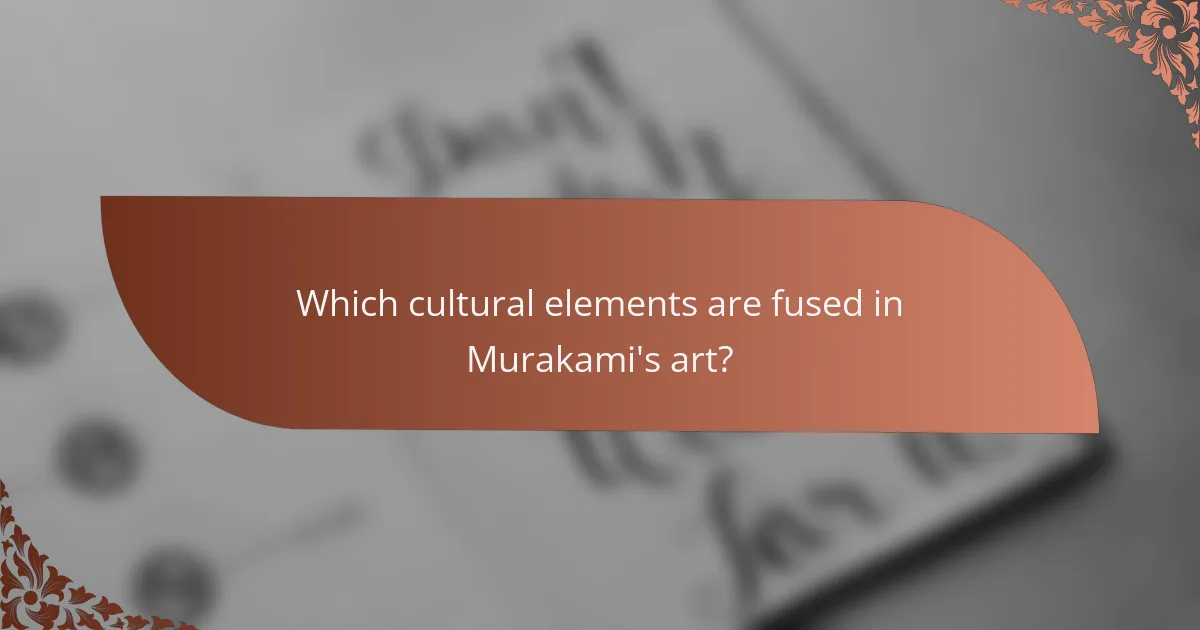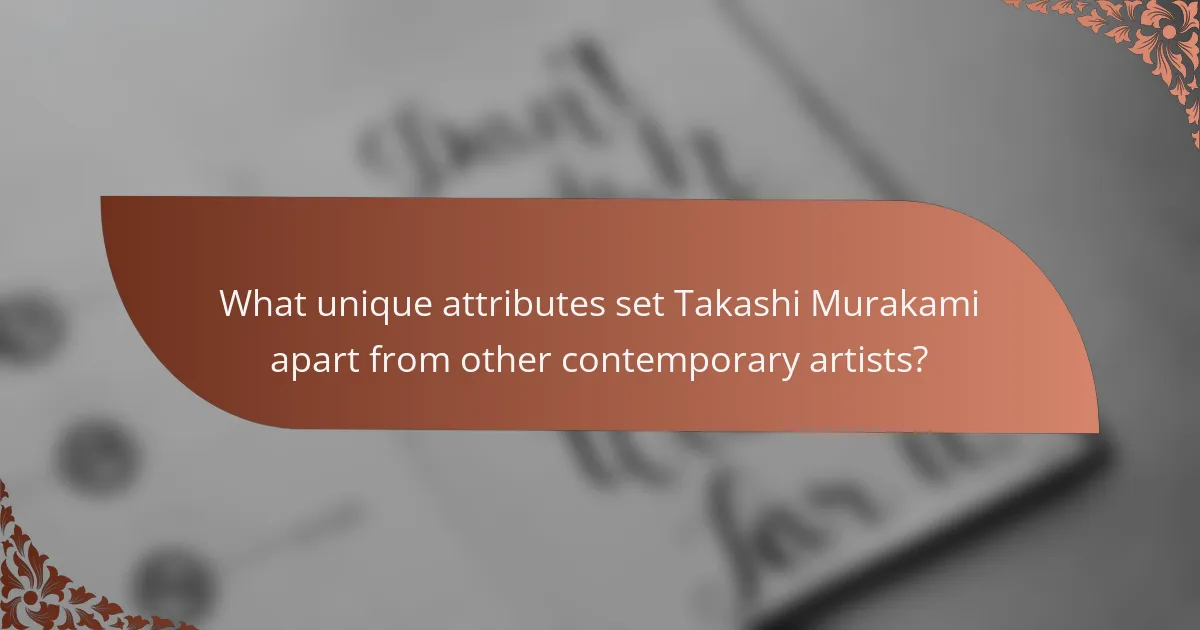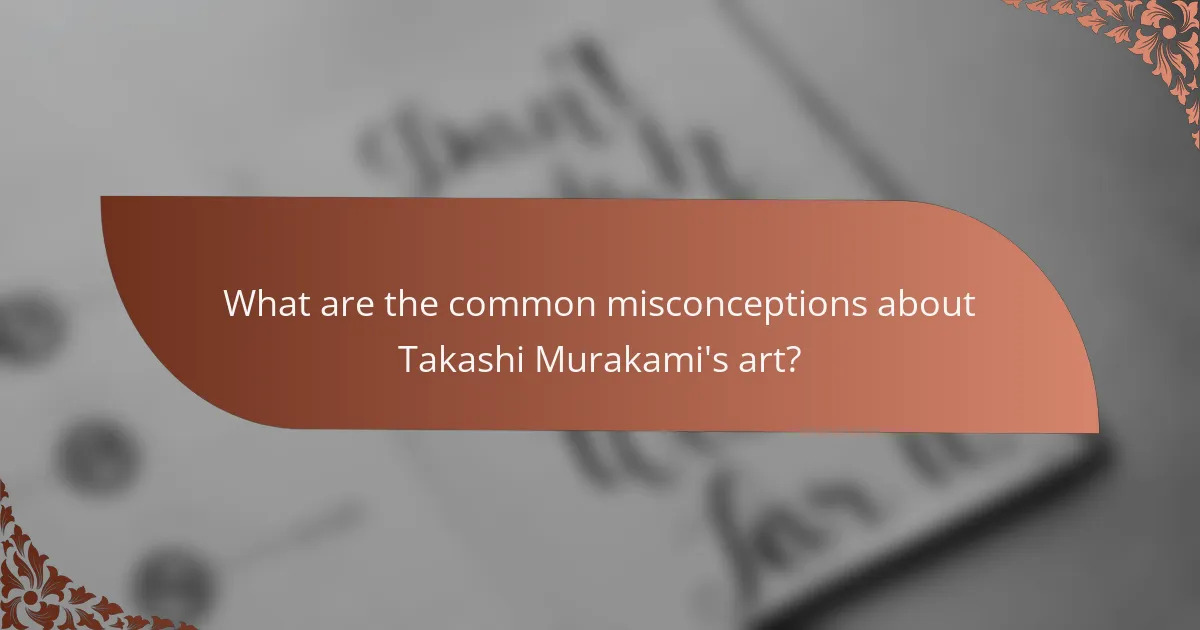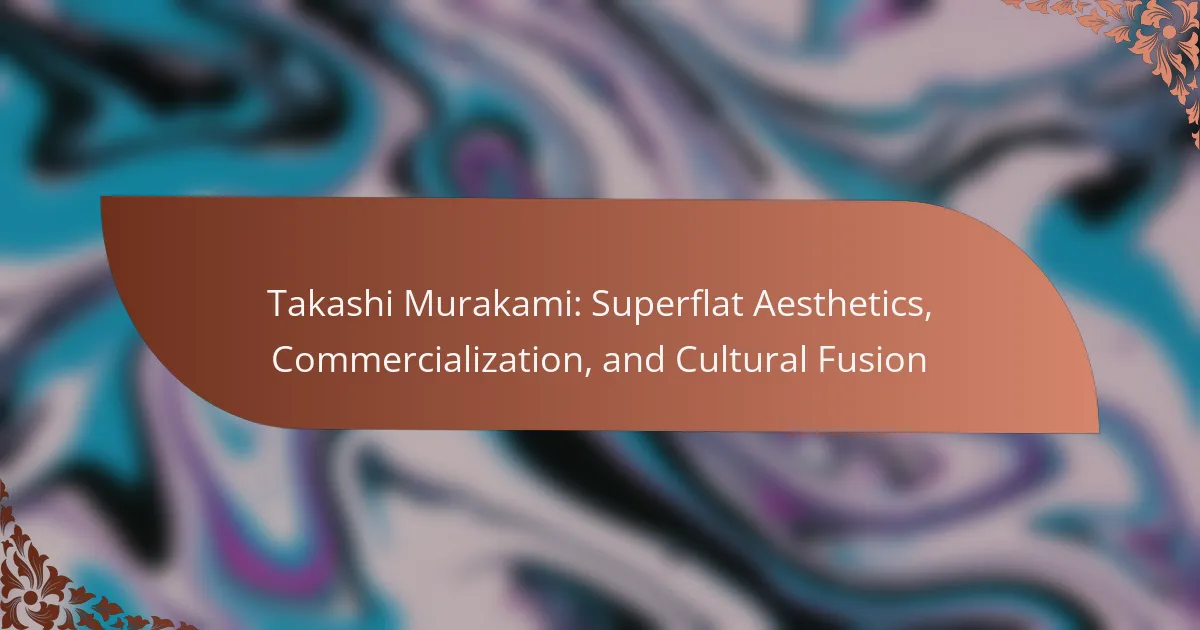Takashi Murakami’s Superflat aesthetics challenge traditional art boundaries by merging high and low culture. This article explores the role of commercialization in his work, his unique fusion of Japanese and contemporary influences, and the misconceptions surrounding his art. Murakami’s collaborations with brands like Louis Vuitton exemplify his innovative approach, making art accessible and relevant in today’s consumer-driven society.

How does Takashi Murakami define Superflat aesthetics?
Takashi Murakami defines Superflat aesthetics as a blend of high and low culture, characterized by flat, two-dimensional imagery and a focus on consumerism. This style critiques traditional art hierarchies, emphasizing the influence of Japanese pop culture and commercialization. Superflat combines vibrant colors and playful themes, creating a unique visual language that reflects contemporary society’s complexities. Murakami’s approach highlights the intersection of art and commerce, making it accessible and appealing to a broad audience.
What are the key characteristics of Superflat art?
Superflat art features flat, two-dimensional aesthetics, blending high and low culture. Key characteristics include vibrant colors, commercial elements, and a focus on consumerism. Takashi Murakami’s work exemplifies these traits, merging traditional Japanese art with contemporary themes. The unique attribute of Superflat art is its critique of superficiality in modern society.
How does Superflat challenge traditional art hierarchies?
Superflat challenges traditional art hierarchies by merging high and low culture, emphasizing commercial appeal. Takashi Murakami’s work blurs boundaries between fine art and consumer goods, democratizing art access. This fusion disrupts elitist perceptions, showcasing art as a product of contemporary culture. The unique attribute of Superflat aesthetics lies in its vibrant, flat imagery that reflects both Japanese pop culture and global commercialization. As a result, Superflat redefines artistic value and relevance in modern society.

What role does commercialization play in Takashi Murakami’s work?
Commercialization plays a crucial role in Takashi Murakami’s work by merging art with consumer culture. His Superflat aesthetics emphasize the blurring of high and low art, making art accessible and appealing to the masses. Murakami’s collaborations with brands like Louis Vuitton exemplify this fusion, showcasing how commercial partnerships enhance artistic visibility. This approach challenges traditional notions of art’s exclusivity, positioning Murakami as a pioneer in cultural fusion and commercialization within contemporary art.
How has Murakami’s art influenced the fashion industry?
Takashi Murakami’s art has significantly influenced the fashion industry through his unique Superflat aesthetics and commercialization strategies. His vibrant, playful designs have been embraced by luxury brands, merging fine art with streetwear. Collaborations with brands like Louis Vuitton exemplify this cultural fusion, showcasing how art can elevate fashion. Murakami’s ability to blend traditional Japanese art with contemporary themes creates a distinct visual language that resonates with diverse audiences. This integration has shifted perceptions, making art more accessible and relevant in fashion contexts.
What are the implications of Murakami’s collaborations with brands?
Murakami’s collaborations with brands blur the lines between high art and commercialism. These partnerships enhance his visibility and introduce Superflat aesthetics to broader audiences. They also raise questions about authenticity and artistic integrity. For example, collaborations with brands like Louis Vuitton showcase cultural fusion while promoting consumerism. This dynamic influences perceptions of art in contemporary society.

Which cultural elements are fused in Murakami’s art?
Takashi Murakami’s art fuses traditional Japanese aesthetics with contemporary pop culture elements. His Superflat style merges influences from ukiyo-e prints and anime, creating a unique visual language. This blend reflects Japan’s commercialization and globalization, showcasing a vibrant cultural dialogue. Murakami’s work often features motifs like flowers and smiling faces, representing optimism amid societal challenges.
How does Murakami incorporate Japanese pop culture in his works?
Takashi Murakami incorporates Japanese pop culture through vibrant visuals, anime influences, and commercial art forms. His Superflat aesthetic blends traditional Japanese art with contemporary themes, creating a unique cultural fusion. Murakami’s characters often reflect elements from manga and video games, appealing to both local and global audiences. This integration promotes a dialogue between high and low culture, showcasing Japan’s dynamic artistic landscape.
What global cultural influences can be seen in Murakami’s pieces?
Takashi Murakami’s works reflect global cultural influences through their integration of Japanese traditions and Western pop culture. His Superflat aesthetics blend anime, manga, and fine art, showcasing a unique cultural fusion. Murakami’s commercialization of art also highlights the impact of consumer culture on contemporary artistic expression. Furthermore, his collaborations with global brands demonstrate the intersection of art and commerce, illustrating how cultural influences transcend geographical boundaries.

How has Takashi Murakami’s work evolved over the years?
Takashi Murakami’s work has evolved significantly, reflecting a blend of traditional Japanese art and contemporary pop culture. His Superflat aesthetic emerged in the late 1990s, characterized by two-dimensional imagery and vibrant colors. Over the years, he embraced commercialization, collaborating with brands like Louis Vuitton, which expanded his reach beyond the art world. Additionally, his fusion of cultural elements has deepened, merging fine art with anime and manga influences, creating a unique identity that resonates globally. This evolution highlights his ability to adapt and innovate within the art landscape.
What are the significant milestones in Murakami’s career?
Takashi Murakami’s career milestones include the establishment of the Superflat movement, significant collaborations with brands like Louis Vuitton, and exhibitions that fused traditional Japanese art with contemporary themes. His 2008 exhibition at the Guggenheim Museum marked a turning point, gaining international recognition. In 2019, he launched the “Murakami Flowers” project, showcasing his unique approach to commercialization and cultural fusion.
How do Murakami’s themes reflect contemporary societal issues?
Murakami’s themes often highlight contemporary societal issues such as consumerism and cultural identity. His Superflat aesthetics critique the commercialization of art, reflecting a society increasingly driven by materialism. This fusion of high and low culture invites dialogue about authenticity in a globalized world. As a result, his work resonates with audiences grappling with the complexities of modern life.

What unique attributes set Takashi Murakami apart from other contemporary artists?
Takashi Murakami stands out due to his unique blend of traditional Japanese art with contemporary pop culture. His Superflat aesthetic merges fine art with commercial influences, creating a distinctive visual language. Murakami’s ability to bridge high and low culture is a rare attribute, allowing him to appeal to diverse audiences. Additionally, his innovative approach to commercialization, exemplified by collaborations with brands like Louis Vuitton, sets him apart in the contemporary art scene.
How does Murakami’s use of color and form differentiate his style?
Takashi Murakami’s use of color and form creates a distinct style characterized by vibrant hues and playful shapes. His Superflat aesthetic merges traditional Japanese art with contemporary culture, emphasizing flatness and surface over depth. This approach enhances commercial appeal, allowing for mass production while retaining cultural significance. Unique attributes include his signature smiling flowers and characters, which convey optimism and challenge conventional art narratives. As a result, Murakami’s work stands out in the art world, blending high art with pop culture.
What personal experiences shape Murakami’s artistic vision?
Takashi Murakami’s artistic vision is shaped by his experiences with Japanese culture, Western influences, and commercial art. His childhood in post-war Japan exposed him to traditional art forms, while his education in the United States introduced him to contemporary art movements. The fusion of these influences is evident in his Superflat aesthetic, which critiques consumerism and blurs the line between high and low art. Murakami’s collaboration with brands like Louis Vuitton further reflects his unique approach to commercialization, merging art with fashion. This blend of cultural elements and personal history defines his distinctive artistic perspective.

What are the common misconceptions about Takashi Murakami’s art?
Many misconceptions exist about Takashi Murakami’s art, particularly regarding its depth and meaning. One common belief is that his work lacks seriousness due to its commercial appeal. However, Murakami’s Superflat aesthetics intentionally merge fine art with pop culture, challenging traditional boundaries. Another misconception is that his art is solely about superficiality; in reality, it addresses complex themes such as identity and consumerism. Additionally, some critics view his collaborations with brands as a dilution of artistic integrity, while Murakami sees them as a form of cultural fusion that democratizes art.
Why do some critics misunderstand the Superflat movement?
Critics often misunderstand the Superflat movement due to its complex blend of commercialism and cultural elements. Takashi Murakami’s work challenges traditional art norms by merging high and low culture. This fusion can lead to misinterpretations of superficiality rather than acknowledging its deeper commentary on consumerism and societal values. Additionally, the movement’s vibrant aesthetics may distract from its critical engagement with contemporary issues. Understanding these nuances is essential for appreciating the movement’s significance.
What are the challenges Murakami faces in the art world?
Takashi Murakami faces challenges in balancing artistic integrity with commercial success. His Superflat aesthetics attract both admiration and criticism. The commercialization of art can dilute his unique cultural fusion, leading to questions about authenticity. Additionally, navigating the global art market requires constant adaptation to shifting trends and audience expectations.
What practical strategies can artists learn from Takashi Murakami’s success?
Artists can learn several practical strategies from Takashi Murakami’s success. Embrace a unique aesthetic, as Murakami did with his Superflat style, which combines traditional Japanese art with contemporary influences. Focus on commercialization by diversifying income streams through collaborations and merchandise. Additionally, engage in cultural fusion to create relatable and innovative works that resonate with a global audience. By adopting these strategies, artists can enhance their visibility and marketability in today’s art landscape.
